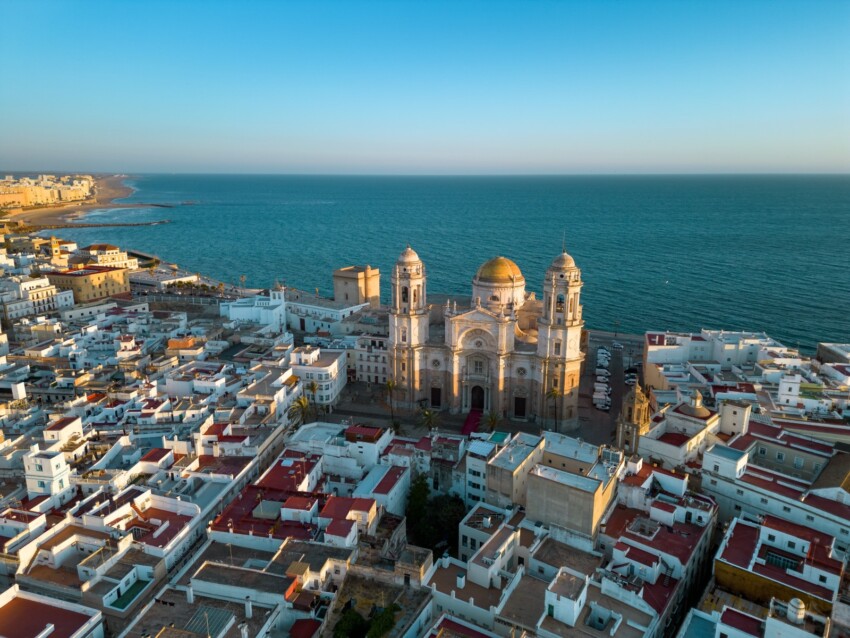

Almost always unjustly snubbed by travellers, Cádiz is an exciting city, full of vitality and interesting attractions, where the air is pervaded by the carefree melodies of the chirigotes and the intoxicating aroma of good food.
The particular shape of Cadiz is in itself reason enough to visit. The heart of the city lies on the central part of a long, narrow peninsula, connected to the mainland by bridges and a tongue of sand. The historical centre comprises three traditional quarters, each with its own special atmosphere; next to these lies a modern area characterised by wide boulevards, seaside promenades and beaches with excellent facilities.
Taking a look at Cadiz’s long history reveals many other good reasons to explore it. It is one of the oldest cities of western Mediterranean civilisation and was the starting point for historic maritime feats such as Columbus’ second and fourth expeditions and Amerigo Vespucci’s first voyage.
Cadiz’s restaurants with their succulent seafood menus, especially the fried dishes, are an irresistible temptation. Once you are seated at a table, have a glass of good wine, perhaps a sherry… and even stop by after dinner for a flamenco show.
When you discover the joviality and goliardic spirit of the citizens of Cadiz, you will want to return during Carnival, one of Andalusia‘s best-loved traditional festivals, which today attracts visitors from all over the world.
So many reasons to come can be summed up like this: if you are looking for an unusual Spanish destination for a city break or beach holiday that combines beach life and urban atmosphere Cadiz is perfect for you!
Cadiz’s attractions are scattered in different parts of the city, all easily accessible on foot or by public transport.
The historical centre is divided into three districts, each with its own distinct personality. The oldest area is Barrio El Populo, which retains its medieval charm; Barrio La Viña is a former fishing village and Barrio Santa Maria is considered the flamenco quarter.
In each district you will find characteristic corners, squares, walks, historical buildings… the list of things to see in Cadiz is surprisingly long!
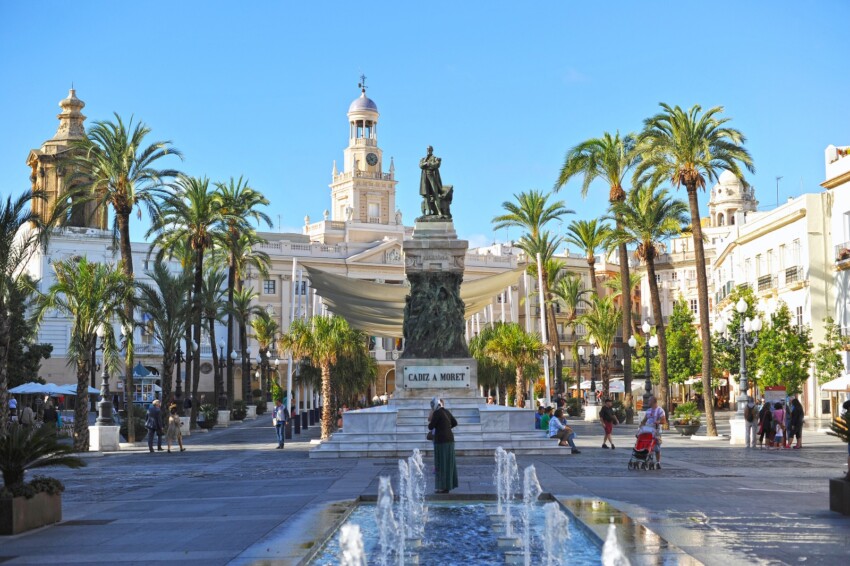
The nerve centre of city life in Cádiz is the beautiful Plaza de San Juan de Dios, the former royal square and parade ground built on reclaimed land reclaimed from the sea. It is an elegant and sunny square, adorned with palm trees, statues and a fountain with water features that is illuminated by LEDs at night.
The square is overlooked by the Town Hall, a historical building in neoclassical style. Other buildings you can admire from this square are the Church of San Juan de Dios and the Casa de los Pazos Miranda.
Animated with people at all hours, Plaza de San Juan de Dios is the perfect place for those who like to watch the hustle and bustle of people passing by or sip a coffee in the open air.
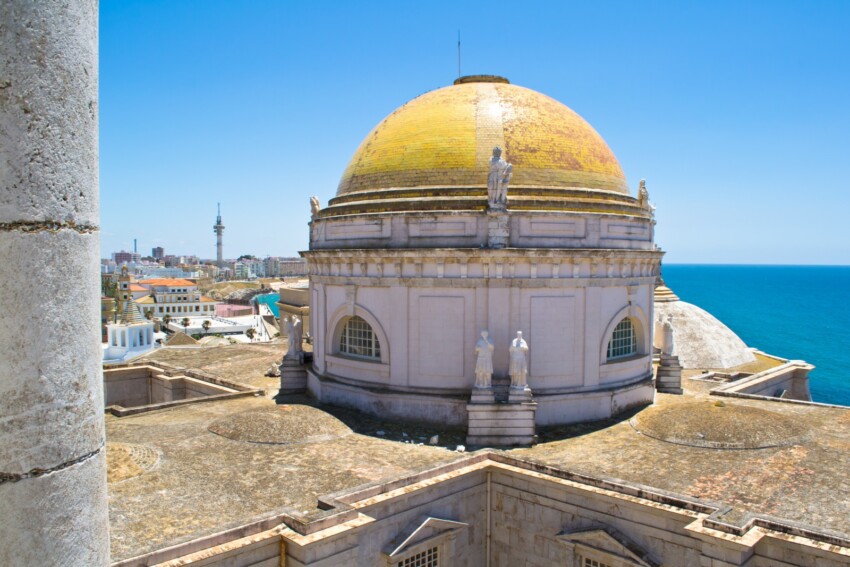
Cadiz’s landmark building is the Cathedral (known as Catedral Nueva), a majestic church overlooking Campo de Sur, a quaint little square a stone’s throw from the coast. Built over a very long period of time, the church mixes Baroque, Rococo and Neoclassical elements and is easily recognisable by its iconic dome covered in yellow azulejos, visible from several points in the city.
The sumptuous white façade conceals an interior no less impressive, rich in works of art, which differs significantly from other famous churches in Andalusia due to the prevalence of neoclassical elements. A special treasure is kept in the crypt: the remains of Spanish composer Manuel de Falla, originally from Cadiz.
The ticket for the Catedral Nueva also includes admission to one of the two bell towers, the Torre del Reloj (clock tower). It is also called the Levante Tower to distinguish it from the other tower to the west.
In total, it is 56 metres high, but visitors can only climb up to 40 metres: a sufficient height to enjoy a spectacular 360° view of the city and the blue expanse of the Atlantic Ocean. The vantage point is accessed via an internal ramp upwards.
The clock that gives the tower its name was added in the mid-19th century and is one of the oldest in Spain. Recently restored, it can now be admired in its original splendour.
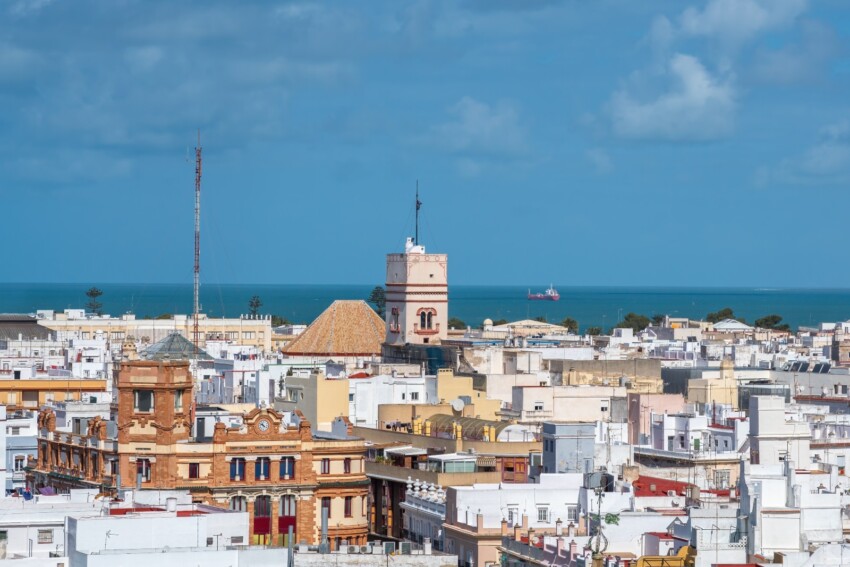
Another tower in Cadiz that can be visited inside is Torre Tavira (Tavira Tower), a square-plan defensive construction built in the 18th century. Standing 45 metres above sea level, it is one of the tallest buildings in the city. Due to its height and position, it is an excellent vantage point from which to observe the panorama.
The tower is worth a visit not only for the view outside, but also for a unique attraction hidden inside. This is a special camera obscura: it is a dark room with a white screen, mirror and magnifying glasses designed to reproduce images of what is happening outside in real time.
A curiosity: the tower is named after Antonio Tavera, the first lookout who served inside it.
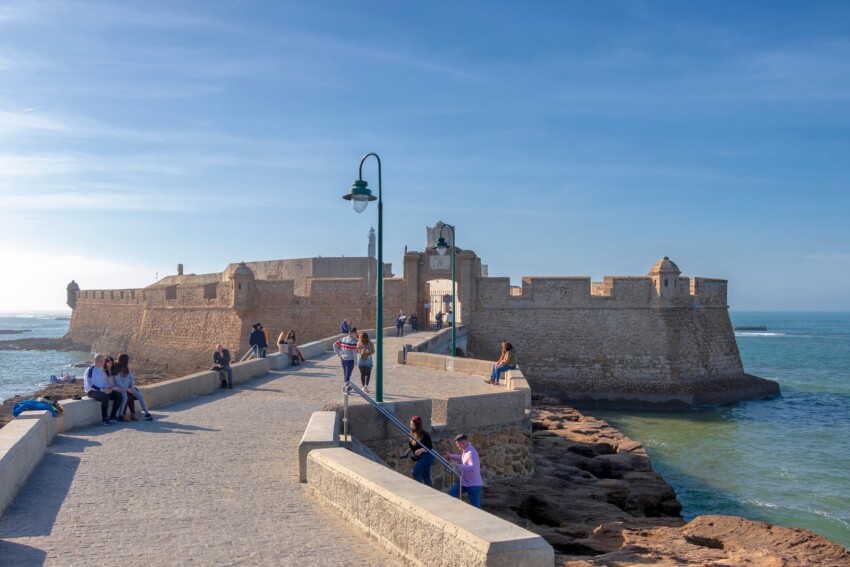
A beautiful walk you can take in Cadiz is along the stone walkway leading to the Castillo de San Sebastian, a cliff-top fortress built on a rocky island connected to the mainland. It is located at the westernmost point of the Cádiz coastline, marking the edge of the city beach of La Caleta.
In practice, the walkway, whose official name is Paseo Fernando Quiñones, allows one to walk in the middle of the sea while always having in front of one’s eyes the splendid view of the castle that seems to emerge from the water.
The castle is used for events and cultural manifestations; there is also a lighthouse about 40 metres high on the island.
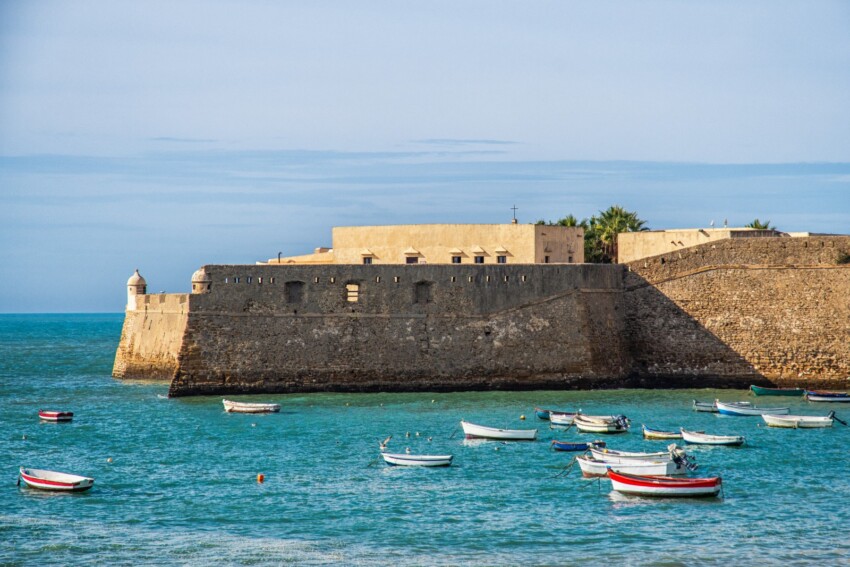
Cadiz’s other fortress is the Castillo de Santa Catalina, an austere building constructed for defensive purposes at the turn of the 16th and 17th centuries at the behest of King Philip II; the design is by the engineer Cristóbal de Rojas.
The Castillo de Santa Catalina, like that of San Sebastian, is also used today as a multi-purpose cultural centre.
If you love the colours, smells and chatter of markets, a must-see attraction in Cadiz is the Mercado Central de Abastos. Here you can buy fresh ingredients such as fruit, vegetables, spices, fish, cured meats and – if you are not a vegetarian – sit at tables to sample chicharrón, a local speciality made from fried pork rinds.
Shopping at the Mercado Central is a good excuse to cross the lively Plaza Topete (also known as Plaza de Flores) and be won over by its genuine folk atmosphere.
Discovered by chance during renovation work in 1980, the Roman Theatre is one of the oldest archaeological remains on the Iberian Peninsula. The structure, dating back to the 1st century B.C., is an extraordinary testimony to the Roman influence in the region. Its monumental dimensions could seat up to 10,000 spectators, making it one of the largest theatres of the time.
The modern interpretation centre offers visitors a complete immersion into the theatre’s history. Through 3D models, information panels and original exhibits, tourists can understand the historical significance of the site. The preserved ruins include part of the original tiers of seats, the orchestra and some decorative elements that testify to the sophistication of Roman architecture.
Looking for refreshment? Take refuge in the Parque Genovés, the city’s green lung. This pretty urban park in the north-west of Cadiz is full of tree-lined avenues, fountains, flower beds and tree sculptures; there is even a small waterfall with a small bridge: although artificial, it is a nice subject for photographs.
Created in the 19th century as a city botanical garden, the park stretches along the oceanfront offering a spectacular combination of nature and art. Its shady avenues are enriched by an extraordinary collection of exotic plants from all over the world, including rare species and hundred-year-old trees that create a unique microclimate.
The most fascinating feature of the park is the large artificial waterfall with scenic grottoes, created in a romantic style. The garden is embellished with art nouveau sculptures, elegant fountains and ornamental ponds. Peacocks strolling freely among visitors add a touch of liveliness, while ornate ceramic benches provide attractive resting spots.
If you are interested in Cadiz’s history and culture, don’t miss a visit to the little-known but well-kept Museo de Cadiz. With free admission, the museum comprises three sections.
The archaeological section exhibits a collection of artefacts that tell of the city’s Phoenician origins and a collection of more recent artefacts dating back to Roman times. The fine arts section exhibits a collection of paintings from the 16th and 20th centuries, including some works by Rubens. The ethnographic section is dedicated to local traditions and includes a collection of satirical puppets.
The Oratory of San Felipe Neri represents one of the most significant places in Spanish constitutional history. This 18th century Baroque jewel is famous for hosting the Cortes de Cadiz during the Napoleonic occupation, when Spain’s first constitution, known as ‘La Pepa’, was drafted and signed here in 1812.
The interior of the oratory is dominated by a magnificent elliptical dome that creates extraordinary lighting effects. The walls are adorned with valuable works of art and Baroque decorations of great artistic value. The original pulpit and carved wooden pews are still preserved, allowing visitors to imagine the historic parliamentary sessions that took place here.
Impossible to get bored during a holiday in Andalusia: this applies to the entire region, including Cadiz. Here, too, you can fill your holiday programme with the most diverse activities: cultural visits, food and wine experiences, outdoor physical activity.
Among the most interesting activities to do in Cadiz we recommend tapas tours, a wine tasting, a day trip to Jerez and the white cities of Andalusia, photography tours, a city tour by bicycle or segway. Want to treat yourself to something special? A catamaran cruise will allow you to admire the city from the sea, lulled by the waves.
For lovers of nature and outdoor activities, a great idea is anexcursion to the Doñana National Park, located about 50 km from the centre of Cadiz.
The city beaches of Cadiz are perfect for combining cultural visits and lazing on the beach in one holiday. The sea is not the most beautiful in Andalusia but it is clean and the services on the beaches are good and all the city beaches are easy to reach.
The easiest beach to reach is La Caleta, a 300-metre-long stretch of golden sand set in a gulf to the west of the old town and bordered by the two fortresses of San Sebastian and Santa Catalina. Another landmark building overlooking this beach is a former thermal establishment. The sea is calm and the seabed is shallow, so safe swimming is possible.
La Caleta is a very popular beach and is often very crowded, so we do not recommend it to those seeking tranquillity. Instead, it is suitable for those who want everything close at hand, families with young children who want services and safety, and young people looking for fun.
The beach has become internationally famous because a famous scene from the film ‘Death Can Wait’ from the James Bond saga was filmed here.
Also in the same gulf is Playa de Palma, which is smaller and more sheltered.
Playa Santa María del Mar is another popular sandy beach and somewhat larger than Caleta. It is about a 15-minute walk from the Cathedral. From here you can swim while admiring the magnificent dome of Cadiz’s most famous church.
If you prefer quieter beaches, move south from the centre. As you move further away you will find less and less crowded beaches, such as Playa de la Victoria.
Moving further on you will arrive at the last city beach in Cadiz, Playa Cortatura. This is the longest and least crowded and there are no hotels in the area. It is perfect for those seeking relaxation.
Do you prefer more fascinating, perhaps wild-looking beaches? You are in the right place. The Costa de la Luz, half of which falls within the territory of the province of Cadiz, is full of breathtaking beaches and coves still little known to tourists.
With a hire car you can reach all the most beautiful beaches in the province of Cadiz in a day trip; some of them can also be reached by bus.
The most famous is Tarifa, considered a surfer’s paradise. Other beaches not to be missed are Conil de la Frontera, Los Caños de Meca, Bolonia and Zahara de los Atunes.
In the following map you can see the location of the main places of interest mentioned in this article.
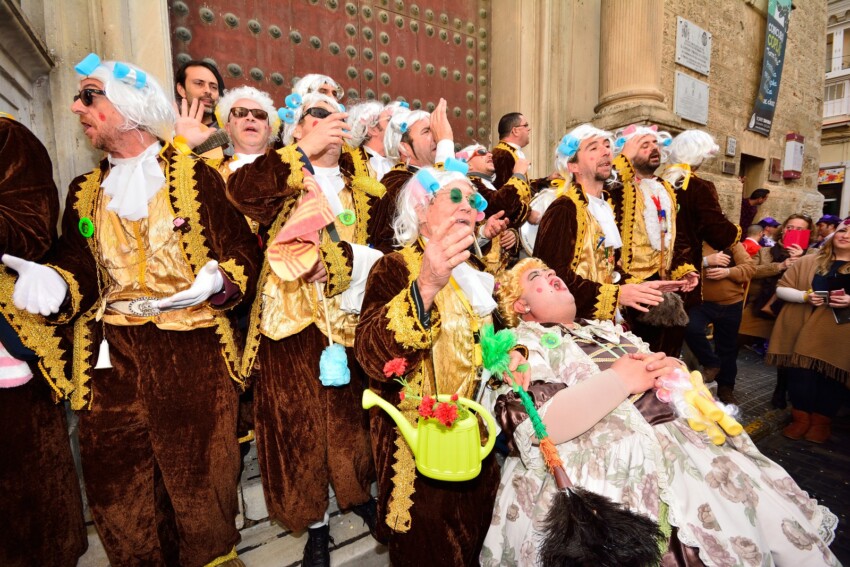
A stay in Cadiz is an excellent opportunity to immerse yourself in the infectious festive atmosphere of Andalusia. The calendar of events and shows in Cadiz is jam-packed, with interesting events all year round.
The top event is the Carnival. It is one of the most famous in Spain and attracts large numbers of visitors from all over Europe. It is a great collective celebration lasting 11 days that takes place in the streets of the city and truly involves everyone: the masked groups that parade on floats and participate in the Falla Theatre Contest, the citizens and tourists. Dressing up is almost obligatory to feel part of the party!
The grand finale of the Carnival of Cadiz starts on Friday and continues throughout the weekend with wild singing and dancing.
As in the whole of Andalusia, the Semana Santa celebrations are very much in evidence here and numerous popular festivities are organised related to patron saints or local gastronomic specialities.
During your holiday in Cadiz, don’t miss the opportunity to attend a flamenco show. Usually, international tourists who want to see this passionate Spanish dance live prefer other places in Andalusia, typically Seville, which means that in Cadiz it is easier to find authentic shows, organised for a local audience.
There are typically three areas to sleep in Cadiz: the centre, the modern city and the beach. Choosing the best area depends on the type of holiday you want to take and your budget.
Most hotels and b&b’s in Cadiz are concentrated in the historical centre, particularly around Plaza de San Juan de Dios. This is the most characteristic area and is recommended for those looking for something romantic and for those travelling by public transport. It is also a good choice for low-cost travellers because there is a good selection of budget accommodation.
If you come to Cadiz for a beach holiday, the beachfront hotels and flats in La Caleta are the best option for you.
The modern area is perhaps less attractive than the old town but is more suitable for those travelling by car because it is easier to find hotels with parking (some free, some for a fee) or parking spaces along the street. The hotels are modern and comfortable and even here you can find sea view rooms if you book a hotel along the Paseo Marítimo.
An important recommendation: if you want to visit Cadiz during Carnival, book well in advance, preferably at least two months in advance. It is one of the most popular festivities in Andalusia and hotels are always sold out, so it is essential to choose your accommodation and confirm as soon as possible.
Cadiz is strategically located: close to two major airports, at the centre of an important road network and served by good rail and bus connections.
The closest airport to Cadiz is Jerez de la Frontera, only 40 km away. Unfortunately, there are not many flights operated, and they are usually not cheap either.
The easiest and cheapest way to get to Cadiz is therefore to take a low-cost flight to Seville. From there, you can easily travel by rental car or public transport. If you choose a car, you can get there quickly by taking the AP4 motorway; you can avoid the motorway toll by opting for the A4, a free but slower road.
If you are already in Spain, you can easily reach Cadiz from many cities. By car, you can travel north along the motorway to Madrid or to Malaga and the beach resorts on the east coast along a major coastal road.
Cadiz’s train station, located close to the centre, is served by local, regional and Intercity trains. Among the most easily accessible locations by train from Cadiz are Jerez, Seville, Cordoba and Madrid.
There are also extra-urban and long-distance buses that connect Cadiz with numerous destinations in Andalusia and the rest of Spain.
What's the weather at Cadiz? Below are the temperatures and the weather forecast at Cadiz for the next few days.
Cadiz is a provincial capital city located along the west coast of Andalusia, the region that occupies almost the entire southern part of Spain. It is 120 km from Seville, the regional capital, 230 from Malaga and 210 from Huelva. Madrid is more than 600 km away.